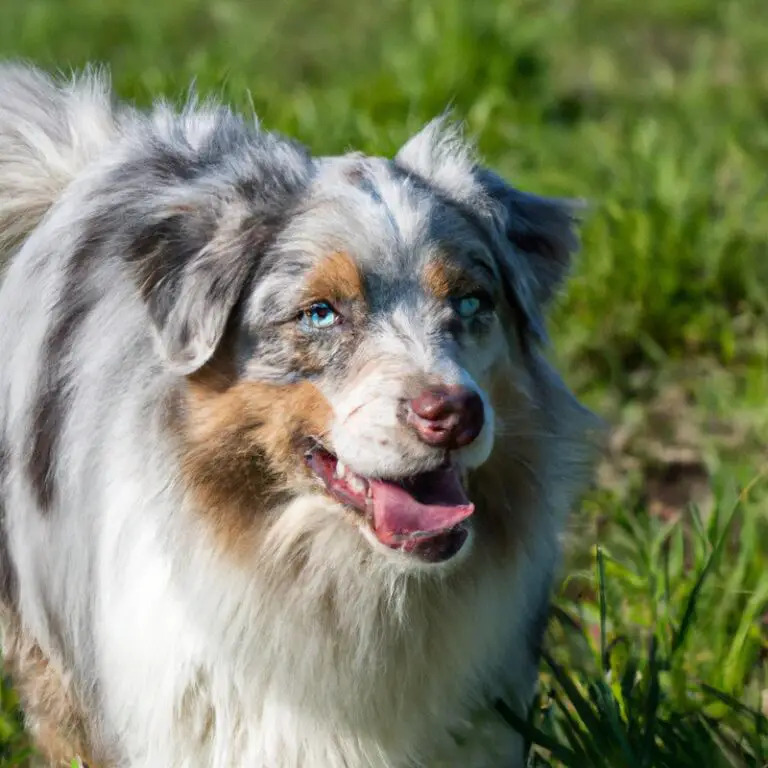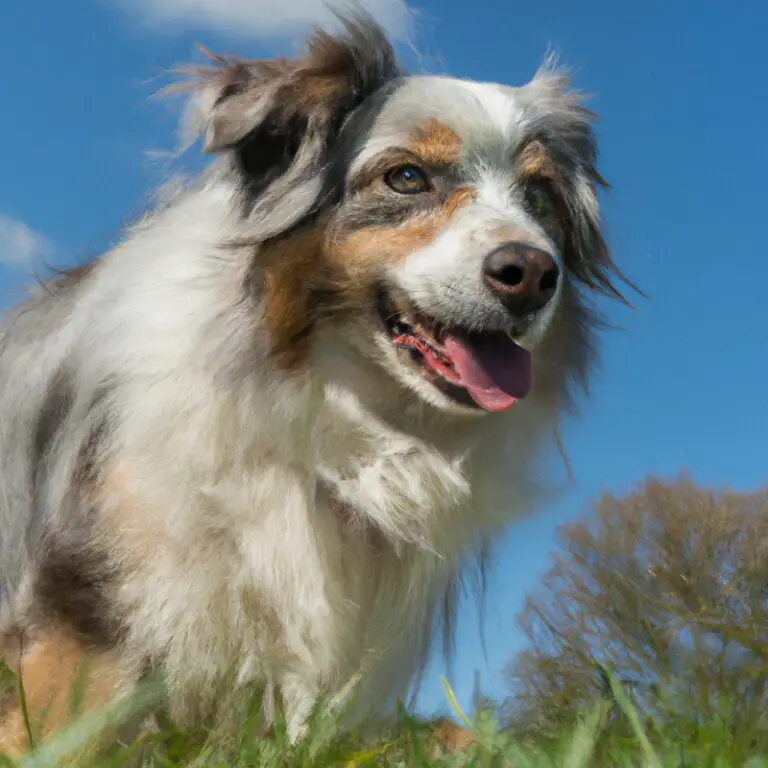What Are The Best Training Methods For Teaching An Australian Shepherd To Roll Over?
Key Takeaways:
- Positive reinforcement is the most effective training method for teaching an Australian Shepherd to roll over.
- Consistency and repetition play a crucial role in successfully teaching an Australian Shepherd to roll over.
- Break down the training process into smaller steps to gradually teach an Australian Shepherd to roll over.
- Patience and persistence are key when training an Australian Shepherd to roll over.
Have you ever marveled at the skill and agility of an Australian Shepherd performing tricks? Teaching your Australian Shepherd to roll over can be a crowd-pleasing and impressive feat, showcasing the intelligence and obedience of this remarkable breed.
But what are the best training methods to achieve this trick?
In this article, I will take you through a step-by-step guide, outlining the benefits of teaching your Australian Shepherd to roll over, understanding their learning style, troubleshooting common challenges, and providing tips for successful training sessions. Get ready to bond with your furry friend and unleash their full potential!
| Training Methods | Pros | Cons |
|---|---|---|
| Positive Reinforcement | 1. Builds trust and strengthens the bond between the owner and the dog. 2. Utilizes rewards to motivate the Australian Shepherd. 3. Encourages desired behavior through positive experiences. | 1. Requires consistency and patience. 2. May take longer for some dogs to learn. |
| Clicker Training | 1. Utilizes a distinct sound (click) to mark the desired behavior. 2. Helps the Australian Shepherd understand exactly when they are doing the right thing. 3. Can be effective for teaching complex tricks or behaviors. | 1. Requires consistent and precise timing. 2. Some dogs may initially find the clicker sound distracting. |
| Shaping | 1. Breaks down the behavior into small achievable steps. 2. Rewards and reinforces each incremental progress. 3. Allows the Australian Shepherd to learn at their own pace. | 1. Can be time-consuming for the owner. 2. Requires good observational skills to recognize and reward small improvements. |
| Modeling | 1. Utilizes a trained dog or a human to demonstrate the behavior. 2. Australian Shepherds can learn by observing and imitating others. 3. Can make the learning process more intuitive and natural. | 1. Requires access to a trained dog or a skilled person. 2. May take longer for the Australian Shepherd to understand what is expected of them. |
Benefits of Teaching an Australian Shepherd to Roll Over
Strengthening the Bond
Strengthening the bond with your Australian Shepherd is an important part of training. Building a strong connection with your dog will not only make the training process easier but also enhance your overall relationship.
Spending quality time together, such as going for walks or playing games, can help deepen the bond between you and your Australian Shepherd.
Additionally, positive reinforcement training methods that focus on rewards and praise can further strengthen your bond. By being consistent, patient, and understanding, you can create a trusting and loving relationship with your Australian Shepherd.

Mental Stimulation
Mental stimulation is a vital aspect of training an Australian Shepherd to roll over. This breed is highly intelligent and thrives on mental challenges.
By engaging their minds, you can keep them mentally stimulated and prevent boredom.
This will make them more focused and eager to learn new commands and tricks. There are several ways to provide mental stimulation for your Australian Shepherd.
One effective method is to use puzzle toys or interactive feeding toys.
These toys require your dog to think and problem solve in order to get a reward. This helps to keep their minds sharp and engaged.
Another great way to provide mental stimulation is through obedience training.
Teaching your Australian Shepherd to follow basic commands such as sit, stay, and lie down can help keep their minds active and focused. As they master these commands, you can gradually introduce more complex tasks, such as rolling over.
In addition, incorporating scent games into your training routine can provide mental stimulation.
Australian Shepherds have a strong sense of smell, and using their nose to find hidden treats or objects can be a fun and challenging game for them. Finally, regular play sessions that involve interactive toys or games can also provide mental stimulation.
Engaging your Australian Shepherd in activities such as fetch, tug-of-war, or hide-and-seek can help keep their minds busy and prevent boredom.
By providing regular mental stimulation, you are not only teaching your Australian Shepherd new tricks, but also helping to keep them happy, healthy, and mentally sharp. So, get creative and have fun with your training sessions to keep your Australian Shepherd’s mind stimulated and engaged.

Physical Exercise
Physical exercise is an essential aspect of training an Australian Shepherd to roll over. Regular exercise helps to keep them physically fit and mentally stimulated.
Australian Shepherds are an active breed that requires daily exercise to prevent boredom and destructive behavior.
Engaging in physical activities such as walking, running, playing fetch, or participating in agility courses can help burn off excess energy and keep your Australian Shepherd focused during training sessions. Not only does exercise improve their overall physical health, but it also promotes better muscle coordination, strength, and flexibility, which are necessary for successful execution of the roll over command.
In addition to enhancing their physical abilities, exercise also plays a role in strengthening the bond between you and your Australian Shepherd.
Spending time together through physical activities helps build trust, mutual understanding, and a sense of companionship. When it comes to physical exercise, remember to tailor the activities to your Australian Shepherd’s age, health condition, and energy level.
Start with shorter sessions and gradually increase the duration and intensity as they build stamina.
It’s important to provide a balance between exercise and rest to avoid overexertion or injury. By incorporating regular physical exercise into your Australian Shepherd’s routine, you are not only meeting their physical needs but also setting them up for success in learning and performing the roll over command.
So, lace up those shoes, grab a ball, and get moving with your furry friend!

Understanding the Australian Shepherd’s Learning Style
Intelligent and Eager to Please
Australian Shepherds are known for their intelligence and eagerness to please their owners. This combination of traits makes them highly trainable and responsive to instruction.
They are quick learners and enjoy being challenged mentally, which means they can pick up new commands and tricks relatively quickly.
When training an Australian Shepherd, it’s important to keep their intelligence in mind and provide them with mental stimulation in addition to physical exercise. By understanding their learning style and using positive reinforcement techniques, you can effectively teach your Australian Shepherd to roll over and many other commands.
Need for Consistency
Consistency is key when it comes to training an Australian Shepherd to roll over. This breed is intelligent and eager to please, but they thrive on routine and repetition.
By being consistent with your training methods and expectations, you will help your Australian Shepherd understand what is expected of them.
Consistency means using the same cues or commands each time you want your dog to perform a certain behavior. For example, if you use the word “roll over” to cue the behavior, stick with that word and avoid using variations like “turn around” or “flip.” This helps your dog associate the cue with the desired behavior.
Consistency also involves maintaining a regular training schedule.
Set aside dedicated time each day for training sessions. Even short 10-15 minute sessions can be effective, as long as they are consistent.
Regular practice will reinforce the behavior and help your Australian Shepherd learn and retain the skill.
Consistency extends beyond just training sessions. It also involves being consistent in your expectations and reactions throughout the day.
For example, if you allow your dog to “roll over” on the furniture sometimes but not others, they may become confused about when the behavior is acceptable.
By consistently reinforcing the desired behavior and providing rewards when they perform the trick correctly, you will help your Australian Shepherd understand what is expected of them.
Positive Reinforcement Approach
When it comes to training an Australian Shepherd to roll over, I highly recommend using a positive reinforcement approach. This means rewarding your dog for desired behaviors rather than punishing them for mistakes.
Positive reinforcement is a gentle and effective method that helps build trust and strengthen the bond between you and your furry friend.
By using treats, praise, and other rewards, you can encourage your Australian Shepherd to learn and perform the roll over command. Start by breaking down the behavior into smaller steps, rewarding your dog for each successful attempt.
Over time, gradually increase the difficulty until your pup can complete the full roll over motion.
Consistency is key when using positive reinforcement. Make sure to use the same cues and rewards each time you train your Australian Shepherd.
This will help them understand what is expected of them and reinforce the desired behavior.
Avoid punishment or harsh training methods when teaching your Australian Shepherd to roll over. These methods can damage the trust and bond you have with your dog and may lead to fear or anxiety.
Remember, positive reinforcement is all about creating a positive learning environment and making training enjoyable for both you and your furry friend.
Step-by-Step Guide to Teaching an Australian Shepherd to Roll Over
Creating a Positive Learning Environment
When teaching your Australian Shepherd to roll over, creating a positive learning environment is key. This means setting the stage for success and making the training experience enjoyable for your furry friend.
Start by finding a quiet, distraction-free area where you can focus on the training session.
Use plenty of treats and praise to motivate and reward your dog’s efforts. Keep training sessions short and frequent to maintain your dog’s interest and prevent them from getting bored.
Remember, a positive learning environment will help your Australian Shepherd thrive and learn new tricks effectively.
Teaching the Basic Commands
When teaching the basic commands to an Australian Shepherd, it is important to start with the essentials. Begin by teaching commands such as “sit,” “stay,” and “come.” These commands lay a solid foundation for further training.
Use positive reinforcement techniques, such as treats and praise, to encourage your Australian Shepherd to comply with these commands.
Be patient and consistent in your training sessions, and gradually increase the difficulty as your dog becomes more proficient. With time and practice, your Australian Shepherd will master the basic commands and be ready to learn more advanced tricks and behaviors.
Introducing the Roll Over Command
To introduce the roll over command to your Australian Shepherd, start by creating a positive learning environment. Make sure you have treats and a quiet, distraction-free space.
Begin by practicing basic commands such as sit and down to establish a foundation of obedience.
Once your dog is comfortable with these commands, you can introduce the roll over command. To teach the roll over, use a lure such as a treat or toy to guide your dog’s movements.
Start by having your dog lie down and hold a treat near their nose.
Slowly move the treat in a circle toward their shoulder, encouraging them to roll onto their side. Reward them with the treat and praise.
Repeat this process, gradually increasing the speed and angle of the roll until your dog completes a full roll over.
Another technique called shaping involves breaking down the roll over into smaller steps. Begin by rewarding your dog for any attempt to roll over, such as shifting their weight or moving onto their side.
Gradually shape their behavior by rewarding them for rolling a little further each time.
With consistency and patience, your Australian Shepherd will learn to roll over on command. Lastly, capturing involves observing your dog’s natural behavior and rewarding them when they perform a desired action.
If you notice your dog spontaneously rolling onto their side or back, immediately praise and reward them.
Pair this behavior with a command such as “roll over” to teach them to associate the action with the command. Remember, each dog learns at their own pace, so be patient and keep training sessions short and fun.
With positive reinforcement and consistent practice, your Australian Shepherd will be rolling over in no time!
Popular Training Methods for Teaching an Australian Shepherd to Roll Over
Luring Technique
The luring technique is a popular method for teaching an Australian Shepherd to roll over. It involves using a treat or a toy to guide the dog into the desired position.
Here’s how it works:
- Hold a treat or a toy close to your dog’s nose, keeping it just out of reach.
- Slowly move the treat or toy in a circular motion, leading your dog to follow it with their nose.
- As your dog follows the treat or toy, they will naturally start to roll over onto their side.
- Once your dog is in the rolled-over position, reward them with the treat or toy and praise them with words like “good job!”
The luring technique is effective because it taps into your dog’s natural instinct to follow movement and seek rewards. It allows you to guide your dog into the desired position without using force or intimidation.
Remember to be patient and consistent during the training process.
Practice the luring technique in short, regular sessions to help your Australian Shepherd learn and master the roll over command. With time and practice, your dog will be rolling over on cue like a pro!
Shaping Technique
The shaping technique is a popular method for teaching an Australian Shepherd to roll over. It involves breaking down the behavior into small steps and rewarding the dog for each progressive action.
Here’s how it works:
- Start with a simple command, like “down,” and reward your dog for following it.
- Once they are consistently getting into the down position, begin to reward them for shifting their weight onto one side.
- Progressively reward your dog for rolling onto their side, then for rolling onto their back.
- Finally, reward your dog for completing the full roll over.
This method requires patience and consistency, but it is effective in teaching complex behaviors like rolling over. Remember to reward your dog with treats, praise, and plenty of positive reinforcement throughout the process.
With time and practice, your Australian Shepherd will master the roll over command using the shaping technique.
Capturing Technique
The capturing technique is a simple and effective method for teaching an Australian Shepherd to roll over. This technique involves waiting for your dog to naturally perform the behavior and then immediately rewarding them.
Here’s how it works:
- Keep an eye on your dog during playtime or training sessions, and patiently wait for them to roll onto their back.
- As soon as they do, say “roll over” or any other verbal command you choose to use.
- Immediately give them a treat and provide lots of praise and positive reinforcement.
- Repeat this process multiple times, gradually adding the verbal command before they perform the behavior.
By capturing the behavior when it naturally occurs and associating it with a verbal command, you are teaching your Australian Shepherd to understand and respond to the “roll over” cue. Remember to always use positive reinforcement and rewards to motivate and encourage your dog throughout the training process.
With patience and consistency, your Australian Shepherd will soon be rolling over on command!
Troubleshooting Common Challenges During Training
Lack of Motivation
Sometimes, when training an Australian Shepherd to roll over, you may encounter a lack of motivation. It’s important to understand that every dog is unique and may respond differently to training methods.
If your Australian Shepherd seems uninterested or unwilling to learn, there are a few strategies you can try.
One common reason for a lack of motivation is that the training sessions may be too long or repetitive. Australian Shepherds tend to have high energy levels and can easily get bored.
To address this, try breaking up your training sessions into shorter, more frequent sessions.
This will help keep your dog engaged and focused. Another way to boost motivation is by using high-value rewards.
Find out what treats or rewards your dog really loves, and use those as incentives during training.
This could be a special treat, a favorite toy, or even praise and affection. By using these rewards, you can make the training more exciting and enticing for your Australian Shepherd.
If your dog still lacks motivation despite these strategies, it might be helpful to go back to basics and review the foundational commands.
Make sure your dog has a solid understanding of basic commands like “sit” and “stay” before moving on to more advanced tricks like rolling over. By strengthening the foundation of their training, you can build their motivation and confidence.
Remember, patience is key when dealing with a lack of motivation.
Every dog learns at their own pace, so don’t get discouraged if progress is slow. Keep the training sessions positive, fun, and rewarding, and gradually increase the difficulty as your Australian Shepherd shows more interest and motivation.
Difficulty with Physical Movement
Teaching an Australian Shepherd to roll over can sometimes present challenges when it comes to physical movement. These dogs are known for their agility and athleticism, but certain factors may make it difficult for them to perform this particular trick.
One common issue is flexibility.
Australian Shepherds are a medium-sized breed with a muscular build, which can limit their range of motion. Some individuals may have stiffer joints or less flexibility than others, making it harder for them to roll over smoothly.
Another factor that can contribute to difficulty with physical movement is the dog’s overall fitness level.
Just like humans, dogs need to be in good physical condition to perform certain movements. If an Australian Shepherd is overweight or lacks muscle tone, it may struggle with the physical demands of rolling over.
It’s also important to consider any underlying health issues that may affect a dog’s movement abilities.
Conditions such as hip dysplasia or arthritis can make it uncomfortable or painful for an Australian Shepherd to perform certain maneuvers. If you suspect your dog is experiencing physical discomfort, it’s best to consult with a veterinarian before continuing with training.
To address these challenges, it’s important to take a gradual approach and be mindful of your dog’s limitations.
Provide opportunities for daily exercise to improve overall fitness and flexibility. Incorporate stretching exercises into your routine to help improve range of motion.
Consider breaking down the roll over command into smaller steps and rewarding your dog for each successful attempt.
This will help build confidence and encourage your Australian Shepherd to continue trying. Additionally, using treats or toys as motivation can help overcome physical limitations and make the training process more enjoyable for your dog.
Keep in mind that each dog is unique, and it may take some time and experimentation to find the right approach for your Australian Shepherd.
Overcoming Fear or Anxiety
Overcoming fear or anxiety when training your Australian Shepherd to roll over is important for their overall progress and well-being. It’s natural for some dogs to feel nervous or hesitant when learning new commands.
To help them overcome their fears, I recommend taking a gradual approach.
Start by creating a positive and safe learning environment for your dog. This can be done by using treats, praise, and rewards to reinforce good behavior.
Take your time and be patient with your dog, as rushing the process can exacerbate their anxiety.
Another helpful technique is desensitization. Gradually expose your dog to the movements and actions involved in rolling over, starting with smaller steps.
For example, you can ask them to lie down on their side before attempting the full roll over.
This gradual progression can help build their confidence. Consistency is key when addressing fear or anxiety.
Stick to a regular training schedule and use the same cues and commands each time.
This establishes a familiar routine and provides a sense of security for your dog. If your Australian Shepherd continues to struggle with fear or anxiety during training, it may be beneficial to consult with a professional dog trainer or behaviorist.
They can provide guidance and customized strategies to help your dog overcome their specific challenges.
Remember, every dog is unique, and it may take time for your Australian Shepherd to feel comfortable rolling over. Stay patient, positive, and supportive throughout the process, and celebrate even the smallest victories along the way.
Tips for Successful Training Sessions
Short and Regular Training Sessions
Short and regular training sessions are key when teaching an Australian Shepherd to roll over. These sessions should be kept brief, ideally around 5 to 10 minutes each.
This helps to keep your dog engaged and focused, preventing them from getting bored or overwhelmed.
By breaking the training into shorter sessions, you can also avoid overloading your dog with information. Remember, Australian Shepherds are intelligent dogs, but they may still need time to process and understand what you’re teaching them.
Consistency is important, so try to have regular training sessions each day or every other day.
This will help reinforce what your dog has learned and allow them to progress at a steady pace. It’s better to have brief, frequent sessions than one long session once in a while.
During the training sessions, make sure to provide clear instructions and rewards for your dog’s progress.
Stay positive and patient, as it may take some time for your Australian Shepherd to master the roll over command. Celebrate small achievements along the way to keep them motivated and engaged.
Remember to always end each training session on a positive note, even if your dog hasn’t fully grasped the roll over command yet.
This will leave them feeling encouraged and excited for the next session.
Patience and Persistence
When it comes to training your Australian Shepherd to roll over, patience and persistence are key. Teaching a new command takes time and effort, so it’s important to approach the process with a patient and determined mindset.
Your Australian Shepherd may not learn to roll over overnight, and that’s okay.
It’s important to remember that every dog learns at their own pace. Be patient with your pup and celebrate even small progress along the way.
Consistently repeating the training sessions and giving your dog time to understand and practice the command will yield better results.
Persistence is also important. Even if your Australian Shepherd doesn’t grasp the concept of rolling over right away, don’t give up.
Continue to practice the command regularly and consistently.
Stay positive and encouraging, and your dog will eventually catch on. It’s also important to remember that training takes time.
It can be frustrating at times, but try to stay patient and keep working with your Australian Shepherd.
With time and consistent effort, you’ll see progress and your dog will start to understand and perform the roll over command.
Gradual Progression
When training your Australian Shepherd to roll over, gradual progression is key. Start by teaching them basic commands like “sit” and “lie down” before introducing the more complex “roll over” command.
Break down the rolling over motion into smaller steps, rewarding your dog for each incremental success.
As they become more comfortable with each step, gradually increase the difficulty until they can fully roll over. This approach allows your dog to build confidence, understand the desired behavior, and ensures a positive training experience.
Remember, patience and consistency are essential throughout the gradual progression process.
Avoiding Training Mistakes
Avoiding Harsh Methods
When it comes to training your Australian Shepherd to roll over, it’s important to avoid using harsh methods. Instead, focus on positive reinforcement and gentle techniques.
Harsh methods can lead to fear and anxiety in your dog, which can hinder the training process and damage the bond between you and your pet.
Instead, opt for clear communication, consistency, and patience. Remember, training should be a positive and enjoyable experience for both you and your Australian Shepherd.
So, avoid harsh methods and prioritize your dog’s well-being.
Not Rushing the Process
When it comes to training your Australian Shepherd to roll over, one important tip is to not rush the process. Training takes time and patience, so it’s important to go at your dog’s pace.
Pushing them too quickly can lead to frustration for both of you.
Start by mastering the basic commands and establishing a strong foundation. Once your Aussie is comfortable and confident with these commands, you can gradually introduce the roll over command.
Break the trick down into smaller steps, rewarding and reinforcing each successful attempt.
Remember, consistency is key. Practice regularly, but in short sessions to keep your dog engaged and motivated.
Be clear in your communication and use positive reinforcement to encourage and reward their efforts.
By taking your time and being patient, you’ll have a better chance of success in teaching your Australian Shepherd to roll over.
Consistency and Clear Communication
Consistency and clear communication are key when training an Australian Shepherd to roll over. By consistently using the same commands and techniques, you establish a clear understanding between you and your dog.
This helps them learn and retain the behavior more effectively.
Additionally, clear communication involves using concise cues and body language that your dog can easily understand. Be patient and consistent in your training sessions, and always reward your dog for their successes.
By maintaining consistency and clear communication, you’ll see progress in your Australian Shepherd’s ability to roll over.
Keep up the good work!
Celebrating Success and Progress
Reinforcing Positive Reinforcement
Reinforcing positive reinforcement is essential for successful training. It involves rewarding your Australian Shepherd when they perform the desired behavior.
This helps them associate the action with a positive outcome, making them more likely to repeat it in the future.
To reinforce positive reinforcement, I always make sure to use rewards that my dog finds highly motivating, such as treats, praise, or playtime. I give the reward immediately after my dog completes the behavior correctly to help them make the connection between the action and the reward.
Consistency is key when reinforcing positive reinforcement.
I make sure to reward my dog every time they perform the desired behavior, especially during the initial stages of training. This helps to solidify the connection between the behavior and the reward in their mind.
In addition to immediate rewards, it’s also important to provide ongoing reinforcement.
I gradually decrease the frequency of treats but continue to give verbal praise and physical affection as a form of reinforcement. This helps to maintain the behavior and keep my Australian Shepherd motivated.
It’s crucial to avoid punishment or negative reinforcement during training.
This can confuse your dog and make them less willing to learn. Instead, focus on praising and rewarding the behaviors you want to encourage.
Remember, training your Australian Shepherd to roll over takes time and patience.
By reinforcing positive reinforcement consistently and using rewards that your dog loves, you’ll build a strong bond with your furry friend and achieve success in their training journey.
Gradually Increasing Difficulty
As you progress in training your Australian Shepherd to roll over, it’s important to gradually increase the difficulty of the exercises. This helps to keep your dog engaged and challenged, while preventing boredom or frustration.
One way to do this is by gradually reducing the frequency and duration of treats as your dog becomes more proficient in rolling over.
You can also introduce distractions, such as having other people or pets in the room, to make the command more challenging. Another option is to add a verbal cue, such as saying “roll over” before giving the command.
By gradually increasing the difficulty of the exercises, you can continue to strengthen your Australian Shepherd’s skills and ensure ongoing progress in their training.
Celebrating Milestones
Celebrating milestones is an important part of training your Australian Shepherd to roll over. It’s essential to acknowledge and reward your dog’s progress, no matter how small.
Each milestone reached brings you closer to your goal and strengthens the bond between you and your furry friend.
One way to celebrate milestones is by reinforcing positive reinforcement. When your Australian Shepherd successfully performs a roll over or makes progress in the training process, offer praise, treats, and affection.
This positive feedback will motivate your dog to continue learning and performing well.
Another way to celebrate milestones is by gradually increasing the difficulty of the training exercises. As your Australian Shepherd becomes more proficient in rolling over, challenge them with new variations or distractions.
This will keep their mind engaged and ensure continuous growth in their skills.
Finally, take the time to appreciate and enjoy the progress your dog has made. Training can be a time-consuming process, but it’s important to pause and acknowledge how far your Australian Shepherd has come.
Celebrate each milestone by reflecting on the journey and the achievements you have accomplished together.
Remember, celebrating milestones is not only about recognizing your dog’s accomplishments but also about celebrating the bond and the joy of training together. So, take a moment to cheer for your Australian Shepherd’s achievements and keep pushing forward towards new milestones and successes.
Continuing Education and Training
Advanced Tricks and Commands
Teaching your Australian Shepherd advanced tricks and commands can be a fun and rewarding experience for both you and your furry friend. These advanced skills not only impress others, but they also provide mental stimulation and strengthen the bond between you and your dog.
Some popular advanced tricks and commands to consider teaching your Australian Shepherd include:
- “Speak” or “Quiet”: Teach your dog to bark on command and then respond to a cue to stop barking. This can be helpful in controlling excessive barking and can also be a fun party trick.
- “Fetch specific item”: Train your dog to fetch specific items by name. This can be handy when you need help finding your keys or bringing you a specific toy.
- “Play dead” or “Bang”: Teach your dog to lie down and roll onto their side as if playing dead. This trick is impressive and can also be a useful foundation for other tricks.
- “Paw targeting”: Teach your dog to touch specific objects with their paw, such as a target stick or a doorbell. This skill can be the basis for many other advanced tricks and commands.
- “Jump through a hoop”: Train your dog to jump through a hula hoop. This trick requires coordination and can be a great way to showcase your dog’s agility.
Remember, the key to successfully teaching advanced tricks and commands is to break them down into smaller, manageable steps. Use positive reinforcement techniques, such as treats and praise, to reward your dog for their progress and always keep training sessions short and fun.
With patience and consistency, your Australian Shepherd can master these exciting tricks and commands.
Participating in Dog Sports or Competitions
Participating in dog sports or competitions can be a fun and rewarding experience for both you and your Australian Shepherd. It allows you to showcase the skills and abilities that you have worked so hard to develop during training.
Dog sports and competitions are a great way to challenge your Australian Shepherd mentally and physically, while also strengthening the bond between you and your furry friend.
Engaging in dog sports or competitions provides numerous benefits. It offers mental stimulation for your Australian Shepherd, as they have to think and problem solve in order to navigate an agility course or perform obedience exercises.
Additionally, it provides a form of physical exercise, allowing your Australian Shepherd to burn off excess energy and stay fit.
Participating in dog sports or competitions also allows you to connect with fellow dog enthusiasts. You can share tips and tricks, learn from others’ experiences, and build a supportive network.
It’s a great opportunity to bond with like-minded individuals who share a passion for dogs.
When considering participating in dog sports or competitions, it’s important to start with the basics. Ensure that your Australian Shepherd has a solid foundation of obedience training and understands basic commands.
This will provide a strong starting point for more advanced skills required in various dog sports.
Research different dog sports and competitions to find the one that best suits you and your Australian Shepherd’s interests and abilities. Whether it’s agility, obedience, rally, or flyball, there’s a wide range of options to choose from.
It’s important to find a sport or competition that both you and your Australian Shepherd enjoy and are motivated to participate in.
As you start participating in dog sports or competitions, remember to have fun and enjoy the experience. Celebrate your achievements, both big and small, and acknowledge the progress you and your Australian Shepherd are making.
Keep a positive attitude and embrace the learning process.
Dog sports and competitions are a journey, and it’s the journey that truly matters. So, if you’re looking for a way to challenge and engage your Australian Shepherd, participating in dog sports or competitions is a fantastic option.
It provides mental stimulation, physical exercise, and strengthens the bond between you and your furry friend.
Take the leap and see where this exciting journey takes you and your Australian Shepherd.
Maintaining a Lifelong Learning Mindset
Maintaining a lifelong learning mindset is essential when it comes to training your Australian Shepherd. As a dog owner and trainer, I have found that staying open to new knowledge and techniques helps me adapt and grow as a trainer.
There is always something new to learn about dog behavior, training methods, and even the latest research on training techniques.
By making a commitment to ongoing education and training, you can continuously improve your skills and deepen your understanding of your Australian Shepherd’s needs. This mindset allows you to stay up-to-date with the latest training methods and strategies, ensuring that you are providing the best possible guidance for your furry friend.
To maintain a lifelong learning mindset, seek out reputable sources of information such as books, online courses, and workshops.
Joining dog training communities or forums can also be a great way to connect with other trainers and exchange ideas. Don’t be afraid to ask questions and seek guidance from experienced trainers who share their knowledge and experiences.
Additionally, be open to feedback and learn from your own experiences.
Not every training technique will work perfectly for every dog, so staying flexible and willing to adjust your approach is key. Remember that training is a journey, and it’s okay to make mistakes.
Embracing a growth mindset will help you see challenges as opportunities for growth and improvement.
Finally, remember to have fun! Training your Australian Shepherd should be an enjoyable experience for both of you. By maintaining a lifelong learning mindset, you’ll continue to find new and exciting ways to bond with your pup while helping them learn and grow.
So, keep that curiosity alive, stay open to new ideas, and enjoy the journey of lifelong learning with your Australian Shepherd.
Final Verdict
Teaching an Australian Shepherd to roll over not only strengthens the bond between you and your dog, but also provides mental stimulation and physical exercise. By understanding their learning style and utilizing positive reinforcement techniques, you can successfully teach this trick step-by-step.
While troubleshooting common challenges and avoiding training mistakes, remember to celebrate success and progress.
Additionally, continuing education and training will allow you to explore advanced tricks and commands, participate in dog sports or competitions, and maintain a lifelong learning mindset. With patience, consistency, and clear communication, you and your Australian Shepherd can achieve great results together.







